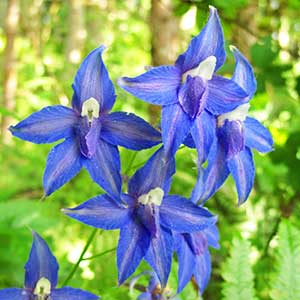Delphinium trolliifolium
Delphinium glaucum
Columbian larkspur, cow-poison, poison delphinium, poison larkspur
Brown's larkspur, duncecap larkspur, giant, giant larkspur, glaucous larkspur, Hooker's larkspur, mountain, mountain larkspur, or tall larkspur, pale larkspur, pale-flower Brown's larkspur, Sierra larkspur, tall larkspur, western larkspur
(40-)60-120(-180) cm;
base usually reddish, glabrous to puberulent.
(60-)100-200(-300) cm;
base usually green, glabrous, glaucous.
blade ± pentagonal, 4-8 × 7-16 cm, margins ± incised, nearly glabrous; ultimate lobes 0-9, width 15-30 mm (basal), 5-20 mm (cauline), widest at middle or in proximal 1/2.
blade round to pentagonal, 2-11 × 3-18 cm, margins seldom laciniate, glabrous; ultimate lobes 5-9(-15), width 5-24(-35) mm, tips abruptly tapered to mucronate apex;
midcauline leaf lobes more than 3 times longer than wide.
(5-)14-40(-75)-flowered, ± open, at least 2 times longer than wide;
pedicel 1-4(-9) cm, puberulent to glabrous;
bracteoles (2-)6-12 mm from flowers, green, linear, 5-9(-14) mm, puberulent.
(13-)40-90(-140)-flowered;
pedicel 1-3(-5) cm, puberulent or glabrous;
bracteoles 2-6(-10) mm from flowers, green to blue, linear, 2-7 mm, puberulent or glabrous.
sepals dark blue, glabrous, lateral sepals spreading, (8-)14-21 × 5-9 mm, spurs straight or downcurved at apex, within 20° of horizontal, (10-)16-23 mm;
lower petal blades covering stamens, 5-10 mm, clefts 1.5-3 mm;
hairs sparse, mostly near junction of blade and claw, centered or on inner lobes, well dispersed, yellow.
sepals bluish purple to lavender, puberulent, lateral sepals forward pointing to spreading, 8-14(-21) × 3-6 mm, spurs straight, ascending to ca. 45°, 10-15(-19) mm;
lower petal blades ± covering stamens, 4-6 mm, clefts 1-3 mm;
hairs centered, mostly near base of cleft, white.
(15-)23-34 mm, 3.8-5.5 times longer than wide, glabrous.
9-20 mm, 3.5-4.5 times longer than wide, glabrous to puberulent.
unwinged;
seed coats smooth.
wing-margined;
seed coat cells elongate but short, surfaces smooth or roughened.
= 16.
= 16.
Delphinium trolliifolium
Delphinium glaucum
Delphinium trolliifolium occurs in the northern Coast Range of California, the Columbia River Valley to just east of Mt. Hood, and the Willamette Valley of Oregon upstream to Lane County. California plants differ somewhat from Oregon plants in pubescence patterns and habitat preferences. Further study may show that two entities are involved here.
Hybrids between Delphinium trolliifolium and D. decorum, D. menziesii subsp. pallidum (D. ×pavonaceum Ewan, Peacock larkspur), D. nudicaule, D. nuttallianum, and D. nuttallii are known. Delphinium trolliifolium is likely to be confused only with D. bakeri. Refer to discussion under that species for differences.
(Discussion copyrighted by Flora of North America; reprinted with permission.)
At the sites in Manitoba and Saskatchewan, Delphinium glaucum is naturalized, not native.
Delphinium glaucum hybridizes extensively with D. barbeyi in Utah and Colorado to the extent that hybrids [D. ×occidentale (S. Watson) S. Watson] are more common in many areas than individuals of either parental stock. It occasionally hybridizes with D. distichum, D. polycladon, D. ramosum, and D. stachydeum. Hybrids with D. brachycentrum are called D. ×nutans A. Nelson.
Tremendous variation is apparent in what is here recognized as Delphinium glaucum. This is the northern expression of the complex described in the discussion under Delphinium subsect. Exaltata. Although some geographic patterns are apparent in the variation within D. glaucum, infraspecific entities are not here recognized. Apparently because of rather recent and/or incomplete genetic isolation, the degree of differentiation between these units is not such that they can be consistently recognized.
Specimens named Delphinium splendens represent plants grown in high-moisture, low-light conditions and may occur as sporadic individuals anywhere from California to Alaska. Type specimens of D. brownii Rydberg, D. canmorense Rydberg, and D. hookeri A. Nelson represent plants grown on relatively dry sites at high latitudes. Plants from dry sites at low latitudes are represented by D. bakerianum Bornmüller and D. occidentale var. reticulatum A. Nelson. Plants with lavender to white flowers are represented by type specimens of D. brownii forma pallidiflorum B. Boivin and D. cucullatum A. Nelson. Type specimens of D. alatum A. Nelson and D. glaucum var. alpinum F. L. Wynd (an invalid name) represent plants growing above or near treeline.
Delphinium glaucum may be confused with D. californicum, D. exaltatum, D. polycladon, or D. stachydeum. For distinctions from D. californicum, see discussion under that species. Absence of basal or proximal cauline leaves, generally much larger plants (greater than 1.5 m), more flowers in the inflorescence, and shorter petioles on the leaves of D. glaucum are features that serve to distinguish this species from D. polycladon. In the latter, the leaves are primarily on the proximal stem, plants often less than 1.5 m, flowers more scattered, and petioles more than twice the length of leaf blades. Features of the sepals may be used to distinguish D. glaucum (dark lavender to blue purple, usually only minutely puberulent) from D. stachydeum (bright blue, densely puberulent). Vegetative parts of D. stachydeum are also densely puberulent, while those of D. glaucum typically are glabrous.
(Discussion copyrighted by Flora of North America; reprinted with permission.)
- Local floras:
BC,
CA,
OR,
WA
- Local Web sites:
CalFlora,
CalPhotos,
Flora NW,
PNW Herbaria,
Turner Photog.
WildflowerSearch
iNaturalist (observations)
USDA Plants Database
- LBJ Wildflower Center
- SEINet
- Plants of the World Online
- Encyclopedia of Life
- Wikipedia
- Google Image Search


